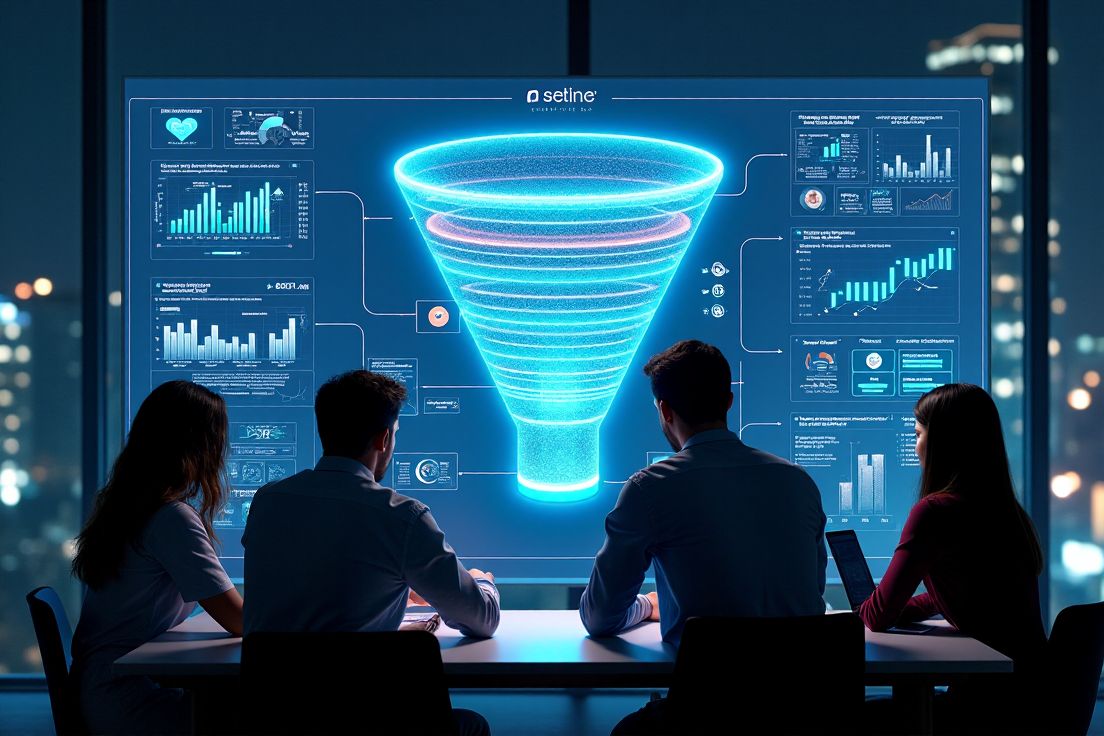How AI Can Help You Build a More Effective Lead Generation Funnel
Welcome to our blog post on mastering lead generation funnels! If you’re looking to boost your business by attracting more customers, understanding lead generation is key. A lead generation funnel is like a path that potential customers follow, from realizing they have a need to deciding to make a purchase.
In this post, we’ll break down each stage of the funnel and explore how to effectively guide your leads through their journey. We’ll also show how tools like artificial intelligence can help make this process smoother and more efficient. So, let’s dive in and start mastering the art of lead generation!
Mastering Lead Generation Funnels

Understanding lead generation funnels involves recognizing the various stages that potential customers move through before making a purchase. Each stage serves to guide leads closer to a decision. The awareness stage is where individuals become aware of a problem or need. Here, effective content like blog posts or social media updates can catch their attention.
The next phase, consideration, is critical. During this time, leads seek more information. They compare options and evaluate different solutions. Providing case studies, testimonials, and comparisons can effectively assist them in this stage.
When leads reach the decision phase, they are ready to make a choice. This is where your call-to-action plays an essential role. Clear and compelling CTAs can encourage them to take that final step.
AI can streamline this entire process.
It analyzes data to understand lead behavior better. By automating responses and personalizing content, AI helps maintain engagement throughout the funnel. This tailored approach addresses specific needs and questions at each stage, increasing the likelihood of conversion.
Using insights gained from data also means refining the funnel.
Mastering Lead Generation Funnels Fundamentals
At the heart of lead generation funnels lies an understanding of how potential customers think. From the moment they realize they need something to the point they decide to make a purchase, their journey is structured in stages. Each part of this journey serves a specific purpose, transforming raw interest into qualified leads.
In the initial phase, grabbing attention is key.
This table outlines the stages of the lead generation funnel, highlighting the purpose of each stage in the journey from awareness to purchase decision.
| Stage | Description | Purpose |
|---|---|---|
| Aware | Potential customers realize they have a need or problem. | Capture attention and stimulate interest. |
| Interest | Customers seek more information about solutions. | Engage with educational content and resources. |
| Consideration | Customers evaluate different options available. | Provide comparisons and features to aid decision-making. |
| Intent | Customers show a clear intention to purchase. | Encourage commitment through promotions or demonstrations. |
| Evaluation | Final assessments and consideration before purchase. | Address objections and reinforce value propositions. |
| Purchase | Customer makes the decision to buy. | Facilitate a smooth transaction process. |
This could be through engaging blog posts, informative videos, or eye-catching ads. The goal is to spark curiosity and provide value right away, ensuring that leads feel interested in learning more.
As leads move into the consideration phase, the focus shifts to providing valuable information. This is where educational resources come into play.
Webinars, informative guides, and detailed product descriptions help potential customers understand their options and the benefits of your offering. By answering common questions and addressing concerns, you build trust and credibility.
Once leads are in the decision stage, they are evaluating the best option. Its essential to be clear about what you offer.
This is the time to feature strong calls-to-action that help facilitate the final choice. Persuasive content, such as special offers or limited-time discounts, can effectively convert interest into action.
AI technologies also enhance this entire process. By analyzing user behavior and preferences, AI can tailor content to suit individual needs.
This means that as leads engage with your funnel, they receive information that resonates with their specific circumstances. Automating responses ensures timely communication, keeping potential customers nurtured until they’re ready to buy.
All these elements work together to create a cohesive experience. Understanding each phase and incorporating tools like AI allow businesses to fine-tune their funnels for maximum efficiency, ultimately driving higher conversion rates and better customer satisfaction.
How AI Enhances Target Audience Identification
AI plays a crucial role in identifying your target audience more accurately. By leveraging data analytics, AI can sift through large volumes of information from various sources like social media, web traffic, and customer interactions. This helps businesses uncover patterns and behaviors that might not be easily noticeable.
Machine learning algorithms can analyze user activity, preferences, and demographics, allowing for a more nuanced understanding of potential customers.
With this deep insight, businesses can create detailed audience profiles that highlight key characteristics, interests, and needs.
Furthermore, AI enables segmentation of audiences into different groups based on shared traits. This targeted approach ensures that marketing messages resonate more effectively with each group. Personalized content that speaks directly to the interests of these segments leads to higher engagement and conversion rates.
By continuously analyzing data, AI helps refine these profiles over time. As consumer behavior changes, AI adapts, ensuring that marketing strategies remain relevant and effective. This dynamic identification process allows for timely adjustments in outreach efforts, maximizing the impact of campaigns.
Through automation, businesses can also run targeted campaigns more efficiently.
Leveraging AI for Lead Scoring and Segmentation
AI is transforming how businesses assess and categorize leads. By utilizing advanced algorithms, organizations can evaluate lead quality based on behavior and engagement levels. This process, known as lead scoring, ranks leads according to their likelihood of converting into customers.
AI examines interactions across different channels, noting actions like website visits, email opens, and social media engagement.
It assigns scores that reflect each lead’s interest and intent. Leads with higher scores are more likely to make a purchase, allowing sales teams to prioritize their efforts effectively.
Segmentation is another area where AI excels. Through data analytics, AI identifies distinct groups within your lead database based on shared characteristics.
For instance, it can differentiate between leads who favor certain products and those who respond better to specific marketing campaigns.
This level of granularity enables businesses to customize their marketing efforts. Tailored content and targeted messaging can be directed toward each segment, enhancing the chances of engagement. Instead of a one-size-fits-all approach, businesses can deliver precise information that speaks to the interests and needs of each group.
Moreover, AI continuously learns from data, improving its lead scoring and segmentation models over time. As consumer behaviors shift, AI adapts, ensuring that your marketing strategies remain relevant. This constant evolution allows for agile responses to changes in the market, maintaining effectiveness in outreach efforts.
By integrating AI into lead scoring and segmentation, businesses enhance their ability to connect with potential customers.
This leads to better resource allocation, more effective marketing strategies, and ultimately, higher conversion rates.
Mastering Lead Generation Funnels

Recognizing the importance of follow-up, engaging leads after their initial interest is crucial. Reconnecting through personalized emails or targeted ads can rekindle their interest. This strategy encourages leads to re-engage with your content and offerings, bringing them back into the active consideration phase.
Understanding the metrics behind each stage also helps in improving the funnel.
Tracking how many leads advance from one stage to the next provides valuable insight. More importantly, monitoring drop-off points reveals where you might lose potential customers. Analyzing these areas can highlight necessary adjustments to improve engagement.
Effective lead generation funnels also leverage retargeting strategies.
By displaying ads or content to users who have previously interacted with your brand, businesses can remind leads of their interest. This gentle nudge can be the push they need to continue their journey toward a purchase.
Incorporating testimonials and social proof at various stages builds trust. When potential customers see others benefiting from your product, theyre more likely to feel confident in their decision.
Also, creating urgency through limited-time offers or exclusive deals can accelerate the decision-making process.
Ultimately, refining the engagement tactics used within each stage of the funnel can lead to higher conversion rates. Analyzing data helps find the perfect balance between information delivery and call-to-action strategies. By applying this knowledge, businesses can create lead generation funnels that not only attract but also nurture leads effectively until they make a purchase.
What You Need to Know
Understanding what you need to know for effective lead generation can enhance your marketing efforts significantly. It’s essential to recognize that each stage in the funnel requires specific strategies and tools to maximize engagement and conversion rates.
First, remember that awareness is just the beginning. You’ll want to capture attention with compelling content.
This can be anything from eye-catching headlines to informative blog posts that solve initial concerns. The goal is to make leads curious.
As potential customers show interest, its vital to provide them with valuable resources. Information like how-to guides, product comparisons, and webinars can help build credibility.
When leads know you’re knowledgeable, they are more likely to consider your offerings seriously.
Next, in the decision-making stage, clear calls-to-action are crucial. This is the moment to shine. Offer limited-time deals or free trials to entice leads into making their final purchasing decision.
Understanding the importance of establishing credibility and creating urgency in the decision-making process can significantly impact your conversion rates. Here are some strategies to enhance your approach:
- Showcase your expertise through informative content, such as blogs, webinars, or case studies.
- Incorporate testimonials and reviews from satisfied customers to build trust.
- Create a sense of urgency by highlighting limited-time offers or exclusive promotions.
- Utilize persuasive language in your calls-to-action to encourage immediate responses.
- Provide easy access to additional resources, such as FAQs or support, to address any last-minute concerns.
Highlight what makes your product unique and emphasize the value it brings.
AI tools can optimize this entire process. By analyzing customer data, they can help refine the content sent to leads, ensuring it meets their specific needs. Automating responses can keep potential customers engaged, providing timely information that nudges them along their journey.
Finally, tracking metrics through the funnel is key. By understanding where leads drop off, you can adjust your strategies to keep them moving forward. Regularly reviewing data and campaign performance will help you understand what works and what needs improvement. This ongoing process ensures your lead generation efforts remain effective and responsive to changing customer needs.
Identifying Your Target Audience for Effective Lead Generation
Understanding your target audience is fundamental for successful lead generation. To effectively attract leads, you need to know who they are, what they want, and how they make decisions. Start by gathering data about your current customers. Look into their demographics, interests, and behaviors.
This will help you create a clear picture of your ideal customer.
Next, think about their pain points. What problems do they face that your product or service can solve? Identifying these challenges allows you to tailor your messaging so it speaks directly to their needs.
You can use surveys, interviews, or feedback forms to collect this information and gain deeper insights.
Segment your audience based on the data you gather. Group them into categories based on shared characteristics. This could be age, profession, interests, or buying behavior.
By doing this, you can create more personalized marketing strategies that cater to each group’s specific needs.
AI tools play a significant role in this process. They can analyze large amounts of data quickly and identify patterns that you might miss. With machine learning, AI helps you refine your audience profiles over time.
As it learns more about your customers, it suggests updates to your targeting strategies.
Moreover, AI can assist in creating targeted content that speaks directly to these segments. By delivering the right message to the right audience at the right time, you increase your chances of drawing in leads. This personalized approach not only attracts more leads but also makes it easier to guide them through your lead generation funnel.
An Overview
Having a clear understanding of your lead generation funnel is vital for success. An effective funnel guides potential customers through their journey, from becoming aware of a problem to making a purchase. Each stage plays a unique role in nurturing leads and helping them along the decision-making process.
AI can significantly improve how this funnel operates.
By analyzing data from interactions, AI helps identify where leads may lose interest and what drives them. It can automate responses, ensuring prospects receive timely and relevant information tailored to their needs. This maintains engagement and fosters trust, crucial for moving them closer to a purchase.
Additionally, AI allows for constant adjustment of strategies.
As it learns from ongoing data, it enhances targeting and improves content delivery. This makes messages more personalized, appealing, and effective, ultimately leading to better conversion rates. The goal is to create a seamless experience that not only attracts potential leads but also keeps them engaged until they are ready to buy.
Understanding each stage of the funnel and how AI can optimize these processes ensures businesses can effectively turn interest into sales.
The combination of insightful analytics and tailored content can streamline operations and make the journey smoother for both leads and marketers alike.
Implementing a strategy that blends insightful analytics with customized content can significantly enhance operational efficiency. Here are some key benefits of this approach:
- Enhanced targeting: Gain a deeper understanding of audience behavior to deliver personalized content that resonates.
- Informed decision-making: Utilize data-driven insights to make strategic marketing choices backed by analytics.
- Improved lead nurturing: Streamline communication and engagement processes to better guide leads through the sales funnel.
- Higher conversion rates: Deliver relevant content at the right moment, increasing the likelihood of converting leads into customers.
- Operational efficiency: Reduce manual efforts and improve productivity by automating analytics and content distribution.
Understanding Lead Generation Funnels

Effective lead generation funnels require a deep understanding of customer behaviors and motivations. As potential leads progress through each stage, their needs and concerns evolve. It’s crucial to recognize that simply moving leads from one phase to the next is not enough. Each interaction should be meaningful and tailored to build trust and encourage commitment.
Throughout the awareness phase, capturing the right attention is key. Use engaging content that resonates with potential customers. Informative articles, visuals, and social media posts can spark interest and invite deeper exploration. This initial connection is what draws leads into the funnel.
As leads enter the consideration phase, providing relevant information helps them weigh their options. It’s important to go beyond simply presenting your solution. Offering practical resources such as webinars and detailed guides will empower customers to make educated choices. Addressing their specific questions demonstrates care for their needs.
When leads reach the decision stage, the focus shifts toward clear, persuasive calls-to-action. This is crucial for motivating them to finalize their purchase. Specials, free trials, or exclusive offers can effectively encourage prompt action and remove any hesitation they may have.
Utilizing AI can significantly enhance the functionality of the funnel.
In the decision stage of the sales funnel, it’s essential to implement strategies that can effectively prompt potential customers to take action. The following points highlight key tactics to enhance this phase:
- Incorporate compelling calls-to-action that guide leads toward making a purchase decision.
- Offer time-sensitive discounts to instill a sense of urgency and prompt immediate action.
- Provide free trials or product samples to reduce perceived risk and improve customer confidence.
- Use targeted messaging tailored to the specific needs and concerns of your leads to resonate better with them.
- Leverage AI tools to analyze customer behavior and optimize call-to-action strategies for improved engagement.
AI technologies allow for real-time analysis of each stage, identifying drop-off points and engagement metrics. By understanding how leads interact, businesses can adjust their strategies on the fly. This ensures that content is relevant and timely, keeping potential customers engaged and moving forward.
Moreover, the automation capabilities of AI streamline communication.
By sending personalized messages to leads at critical moments, businesses maintain a strong connection. As leads receive answers to their queries right when they need them, confidence grows, leading to higher chances of conversion.
Incorporating analytics throughout the funnel offers insights that can refine marketing efforts. Knowing which messages resonate, and which dont helps businesses continually improve.
This iterative process can lead to a more effective funnel, making the journey smoother for potential customers.
Ultimately, understanding lead generation funnels requires an ongoing commitment to adapt and optimize. By paying attention to engagement strategies and leveraging AI’s capabilities, businesses can turn interest into action. Ensuring potential customers feel supported and informed at each stage is vital for driving conversions.
Key Concepts and Stages
Understanding key concepts and stages in the lead generation funnel is essential for driving potential customers toward making a purchase. Each stage has a specific goal that helps move leads closer to conversion. The funnel begins with awareness, where potential customers first recognize they have a problem or need. During this phase, creating engaging and informative content is critical to catch their attention and spark interest.
Next comes the consideration stage. Here, leads start actively seeking more information about their options. Providing a variety of educational materials, such as webinars and detailed articles, is beneficial. This not only informs them but also establishes credibility, making them more likely to trust your offerings.
As leads move into the decision stage, they weigh their choices carefully. It’s vital to present clear and persuasive calls-to-action. For instance, highlighting limited-time offers or free trials can motivate them to take action quickly. Addressing any remaining objections or concerns they might have is also important in this stage.
AI technology significantly enhances the effectiveness of the funnel. By analyzing lead behavior, AI can provide insights into where leads may lose interest. It identifies drop-off points and suggests improvements to keep leads engaged. Additionally, AI can automate responses, ensuring that potential customers receive timely and relevant information tailored to their needs.
Identifying Your Target Audience for Lead Generation
Identifying your target audience is essential for effective lead generation. Start by gathering information about your existing customers. Look at their age, location, interests, and buying habits. This data helps you understand who your ideal customer is and what they might need from your product or service.
Next, its important to discover what problems your audience faces. These challenges are often where your offerings can provide solutions. Conducting surveys or interviews can yield useful insights that help you pinpoint these pain points.
After gathering data, segment your audience into different groups.
This could be based on demographics or behaviors. By categorizing them, you can tailor your messaging to address the specific interests and needs of each group. Personalized marketing will resonate more, leading to higher engagement.
AI can significantly enhance this process.
It works by analyzing large datasets quickly, identifying patterns in consumer behavior you might miss. AI helps refine your audience profiles, making them more accurate over time. As AI learns from new data, it can suggest strategies that target your audience more effectively.
Additionally, AI assists in creating tailored content.
How AI-Powered Tools Can Enhance Lead Scoring and Qualification
AI-powered tools significantly improve lead scoring and qualification processes. By utilizing complex algorithms, these tools can analyze a variety of data points related to each lead’s behavior. For instance, tracking interactions across websites, emails, and social media helps determine how interested a lead is in a product or service.
With AI, businesses can assign scores to leads based on their actions.
Higher scores reflect active engagement, such as frequent website visits or clicking on links in emails. This ranking allows sales teams to focus their efforts on leads with the highest potential for conversion.
Furthermore, AI can identify patterns that indicate readiness to buy. For example, if a lead frequently views product pages or requests pricing information, AI can flag them as high-priority.
This level of insight streamlines the qualification process, enabling businesses to respond promptly to interested leads.
Segmentation also benefits from AI technologies. By grouping leads based on shared traits or behaviors, businesses can tailor their marketing approaches. Personalized messages resonate better with specific audiences, increasing engagement.
Additionally, AI continuously learns and adapts over time. As it processes new data, it adjusts lead scores and qualification criteria, making the system smarter and more efficient. This ongoing evolution ensures that businesses remain responsive to changing market conditions and customer preferences.
Integrating AI into lead scoring and qualification not only enhances accuracy but also improves efficiency.
Here are some frequently asked questions (FAQs) regarding lead generation funnels, their stages, and the role of AI in optimizing this process. These questions aim to clarify key concepts and enhance your understanding of effective lead generation strategies.
FAQ
1. What are the main stages of a lead generation funnel?
The main stages of a lead generation funnel include Awareness, Interest, Consideration, Intent, Evaluation, and Purchase. Each stage serves a specific purpose in guiding potential customers towards making a purchase decision.
2. How can I effectively capture leads in the awareness stage?
To capture leads in the awareness stage, utilize engaging content such as blog posts, infographics, and social media updates to stimulate interest and highlight the problems your product or service can solve.
3. What role does AI play in optimizing lead generation funnels?
AI enhances lead generation funnels by analyzing data to understand lead behavior, automating responses, personalizing content, and continuously refining targeting strategies based on ongoing consumer interactions.
4. How can I improve engagement during the consideration stage?
To improve engagement during the consideration stage, provide educational resources such as guides, webinars, and product comparisons that help leads understand their options and build trust in your offerings.
5. What strategies can I implement in the decision phase to encourage purchases?
In the decision phase, implement strong calls-to-action, offer limited-time discounts, provide compelling testimonials, and address any objections to encourage leads to finalize their purchase.
6. Why is audience segmentation important in lead generation?
Audience segmentation is crucial in lead generation as it allows businesses to tailor their messaging to specific groups, improving engagement and increasing the likelihood of conversion by addressing the unique needs of each segment.
7. How can tracking metrics enhance the lead generation process?
Tracking metrics allows businesses to analyze which stages leads drop off, understand engagement levels, and identify areas for improvement, ultimately refining the lead generation funnel to increase conversion rates and customer satisfaction.
Conclusion
Mastering the lead generation funnel is a crucial skill for anyone looking to grow their business. By understanding each stage of the funnelfrom awareness to purchaseyou can effectively guide potential customers through their journey.
Utilizing tools like AI can make this process even smoother. With AIs ability to analyze data and personalize content, you can keep leads engaged at every point, increasing the chances of conversion.





